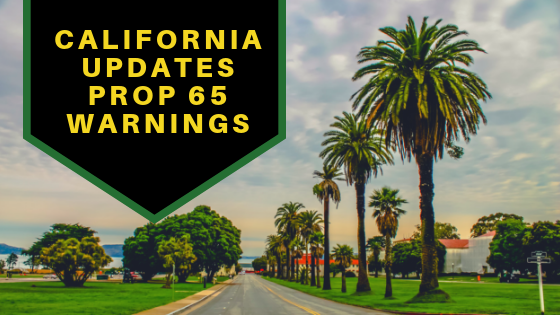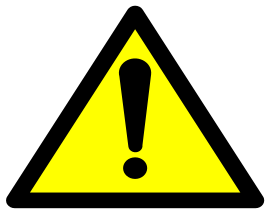
California’s Office of Environmental Health Hazard Assessment (OEHHA) has overhauled the “clear and reasonable” warning regulations for the Safe Drinking Water and Toxic Enforcement Act (Prop. 65), effective August 30, 2018. The new approach is designed to reduce the phenomenon of “over-warning” and to provide more precise information to consumers about the exact chemicals contained in the products to better inform consumer decision making.
Background About Proposition 65
Proposition 65 requires businesses to inform Californians about exposures to chemicals that the State has determined cause cancer, birth defects, or other reproductive harm. Proposition 65 requires businesses to provide a “clear and reasonable” warning (using mandatory language and formatting) before knowingly and intentionally exposing anyone to a listed chemical. Companies with less than 10 employees are exempt from Prop 65’s warning requirements. Furthermore, warnings are not required if the business can show that the anticipated exposure level will not pose a significant risk of cancer or is significantly below established levels observed to cause birth defects or other reproductive harm. To guide businesses in determining whether a warning is necessary, OEHHA has developed safe harbor levels. Thus, a business has “safe harbor” from Proposition 65 warning requirements if exposure to a chemical occurs at or below these levels.
Food producers who use ingredients or packaging known to contain high levels of listed chemicals, such as acrylamide, inorganic arsenic, bisphenol A, cadmium, DHEP, lead, or mercury should conduct comprehensive laboratory analysis of their products to determine the actual levels of listed chemicals. Ingredients that often raise Prop 65 concerns include but are not limited to: rice and concentrated rice-derived products (i.e., rice syrups and protein powders), seaweed, spices, vinegars, coffee, chocolate/cacao, certain fish, shellfish, and organ meats, and plant-based foods that have been browned through roasting, frying, or other heat treatment. That said, the concentration of a chemical in a product is only one part of the process to determine whether consumers must be warned about an exposure to a listed chemical.
Ingredients that often raise Prop 65 concerns include but are not limited to: rice and concentrated rice-derived products (i.e., rice syrups and protein powders), seaweed, spices, vinegars, coffee, chocolate/cacao, certain fish, shellfish, and organ meats, and plant-based foods that have been browned through roasting, frying, or other heat treatment. That said, the concentration of a chemical in a product is only one part of the process to determine whether consumers must be warned about an exposure to a listed chemical.  Among other exemptions, businesses may avoid the warning obligation if they are able to demonstrate that the listed chemicals are “naturally occurring” in their products. However, the “naturally occurring” standard is very difficult to satisfy. Before assuming that the “naturally occurring” exemption applies, companies should seek legal counsel.
Among other exemptions, businesses may avoid the warning obligation if they are able to demonstrate that the listed chemicals are “naturally occurring” in their products. However, the “naturally occurring” standard is very difficult to satisfy. Before assuming that the “naturally occurring” exemption applies, companies should seek legal counsel.
 Recent Changes to Proposition 65 Regulations
Recent Changes to Proposition 65 Regulations
There have been a number of recent changes to the Prop 65 disclosure requirements that bear upon the design and content of food product labels:
- Prop. 65 disclosures are now required to include the specific chemical name of at least one listed chemical that triggered the warning. If the product contains both listed carcinogens and reproductive toxins, the warning needs to include at least one example of each. However, the warning labels need not identify all listed chemicals present in the product by name.As always, the remainder of the required warning language depends on whether the chemical is listed as posing a risk of cancer, reproductive toxicity or both
- Warning labels must also include a URL to the OEHHA’s new Prop. 65 website: www.p65warnings.gov.
- The disclosure must also include the word WARNING in bold capital letters and a triangular warning symbol, printed in yellow unless the product’s sign, label or shelf tag is in black and white.
- If other consumer information on the label is provided in a language other than English, then Prop 65 warning must also be provided in that language.
Additionally, the new regulations shift warning responsibility up the chain of production to manufacturers, distributors or other non-retailers. If a product does not bear the warning on or affixed to a label, a company must provide written notice through the chain of distribution identifying the products at issue and the listed chemicals present in amounts that exceed the safe harbor. Additionally, the notice must include all necessary warning materials, such as the labels or shelf signs, and information about online sales. The company giving notice is also responsible for obtaining written confirmation that the ultimate retailer actually received the notice. Finally, the notice must be renewed within the first six months during the first year after the effective date and annually thereafter.
Retailers maintain the responsibility of warning under the following five circumstances:
- Private-label products — the retailer sells the product under a brand or trademark that it owns or licenses;
- Retailer-prepared or modified products, where the retailer knowingly introduced a listed chemical into the product;
- Retailer-modified labels — the retailer covered, obscured or altered a warning sent via the notice provisions described above;
- Retailer misfeasance — the retailer ignored the notice and warning materials sent to it; or
- Retailer as the only legally responsible party — the retailer had actual knowledge of the potential exposure, and no other upstream company can be served in California or has 10 or more employees.
Managing Consumer Reactions to Proposition 65 Warnings
Many food manufacturers are reticent to include Proposition 65 warnings on their labels because they fear that the mandatory language and symbols will scare off consumers — especially those outside of California who are not familiar with the ubiquitous warnings. (And creating separately labeled inventory for California distribution can be expensive and cumbersome.) Helpfully, OEHHA’s website now contains content designed to better inform consumers about common listed chemicals found in food, including why and how they may unavoidably become a part of food products. Food businesses that have a duty to warn and receive customer inquiries about the warnings may point consumers to these explanatory resources. They can also include truthful explanatory content on their websites to contextualize the warnings.
Compliance with Proposition 65
Failing to warn when necessary can be very risky and may subject a business to a civil lawsuit by the California attorney general or by any private individual acting in the public interest. Since the enactment of Proposition 65, there have been a substantial number of class action lawsuits alleging violations of Proposition 65 associated with the labeling of food products. Because the cost to defend such cases can be overwhelming, it is important for food companies to be proactive about assessing their obligations under Proposition 65, testing their products, and properly communicating warnings when necessary.
We encourage food businesses who market products in California — physically through distribution or virtually through e-commerce — to contact Handel Food Law for legal counsel about Proposition 65 compliance. We are able to guide clients through the process of determining whether warnings are indicated based on disclosures from suppliers and laboratory analysis of finished products, review labels to make sure warnings are appropriately displayed, and refine explanatory content about the Proposition 65 warnings and the presence of listed chemicals.
